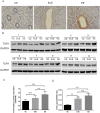LPS/TLR4-mediated stromal cells acquire an invasive phenotype and are implicated in the pathogenesis of adenomyosis
- PMID: 26898650
- PMCID: PMC4761971
- DOI: 10.1038/srep21416
LPS/TLR4-mediated stromal cells acquire an invasive phenotype and are implicated in the pathogenesis of adenomyosis
Abstract
The present study tested whether the LPS/TLR4 signal pathway in endometrial stromal cells is essential for the pathogenesis of adenomyosis. We tested the expression of TLR4, MD2 in the endometrium without adenomyosis (CE), the eutopic endometrium with adenomyosis (EuE) and the ectopic endometrium with adenomyosis (EE). We isolated the stromal cells from CE, EuE and EE (CESC, EuESC, EESC), treated with lipopolysaccharide (LPS) and TLR4 antagonist and detected the cell viability. And we also measured the key protein of the TLR4 signal pathway and inflammatory proliferation and invasive growth of experimental cells. We found that the viability of experimental cells treated with LPS was significantly greater than that of the non-treated cells, blocked by the TLR4 antagonist VIPER. TLR4 signal pathway and inflammatory proliferation and invasive growth of experimental cells stimulated by LPS, and it was inhibited by VIPER. This study suggested that stromal cells were activated by the TLR4 signalling pathway, which processed the cellular inflammatory proliferation and invasive growth involved in the pathogenesis of adenomyosis.
Figures





Similar articles
-
Expression of high-mobility group box-1 in eutopic/ectopic endometrium and correlations with inflammation-related factors in adenomyosis.Gynecol Endocrinol. 2023 Dec;39(1):2269265. doi: 10.1080/09513590.2023.2269265. Epub 2023 Nov 15. Gynecol Endocrinol. 2023. PMID: 37967572
-
Metformin inhibits growth of eutopic stromal cells from adenomyotic endometrium via AMPK activation and subsequent inhibition of AKT phosphorylation: a possible role in the treatment of adenomyosis.Reproduction. 2013 Aug 21;146(4):397-406. doi: 10.1530/REP-13-0135. Print 2013 Oct. Reproduction. 2013. PMID: 23904524
-
Berberine inhibits growth and inflammatory invasive phenotypes of ectopic stromal cells: Imply the possible treatment of adenomyosis.J Pharmacol Sci. 2018 May;137(1):5-11. doi: 10.1016/j.jphs.2017.12.001. Epub 2017 Dec 8. J Pharmacol Sci. 2018. PMID: 29752208
-
Interaction of M2 macrophages and endometrial cells induces downregulation of GRIM-19 in endometria of adenomyosis.Reprod Biomed Online. 2020 Nov;41(5):790-800. doi: 10.1016/j.rbmo.2020.04.022. Epub 2020 May 15. Reprod Biomed Online. 2020. PMID: 32896475
-
Downregulation of DNA methyltransferase 3 alpha promotes cell proliferation and invasion of ectopic endometrial stromal cells in adenomyosis.Gene. 2017 Mar 10;604:41-47. doi: 10.1016/j.gene.2016.12.011. Epub 2016 Dec 14. Gene. 2017. PMID: 27986572
Cited by
-
The Current Understanding of Molecular Mechanisms in Adenomyosis-Associated Infertility and the Treatment Strategy for Assisted Reproductive Technology.Int J Mol Sci. 2024 Aug 16;25(16):8937. doi: 10.3390/ijms25168937. Int J Mol Sci. 2024. PMID: 39201621 Free PMC article. Review.
-
Eutopic/ectopic endometrial apoptosis initiated by bilateral uterine artery occlusion: A new therapeutic mechanism for uterus-sparing surgery in adenomyosis.PLoS One. 2017 Apr 13;12(4):e0175511. doi: 10.1371/journal.pone.0175511. eCollection 2017. PLoS One. 2017. PMID: 28406930 Free PMC article.
-
CA125 modified by PLT and NLR improves the predictive accuracy of adenomyosis-derived pelvic dense adhesion.Medicine (Baltimore). 2017 May;96(19):e6880. doi: 10.1097/MD.0000000000006880. Medicine (Baltimore). 2017. PMID: 28489790 Free PMC article.
-
Berberine attenuates hyperalgesia in mice with adenomyosis.Arch Gynecol Obstet. 2022 Jul;306(1):115-125. doi: 10.1007/s00404-022-06438-y. Epub 2022 Mar 1. Arch Gynecol Obstet. 2022. PMID: 35230500
-
Comparative analysis of endometrial, vaginal, and gut microbiota in patients with and without adenomyosis.Acta Obstet Gynecol Scand. 2024 Jul;103(7):1271-1282. doi: 10.1111/aogs.14847. Epub 2024 Apr 25. Acta Obstet Gynecol Scand. 2024. PMID: 38661227 Free PMC article.
References
-
- Ferenczy A. Pathophysiology of adenomyosis. Hum Reprod Update 4, 312–322 (1998). - PubMed
-
- Korzekwa A., Lupicka M., Socha B., Mannelli C. & Skarzynski D. J. Is adenomyosis a problem in reproduction and fertility? Pol J Vet Sci 17, 187–194 (2014). - PubMed
-
- Benagiano G. & Brosens I. History of adenomyosis. Best Pract Res Clin Obstet Gynaecol 20, 449–463 (2006). - PubMed
MeSH terms
Substances
LinkOut - more resources
Full Text Sources
Other Literature Sources

